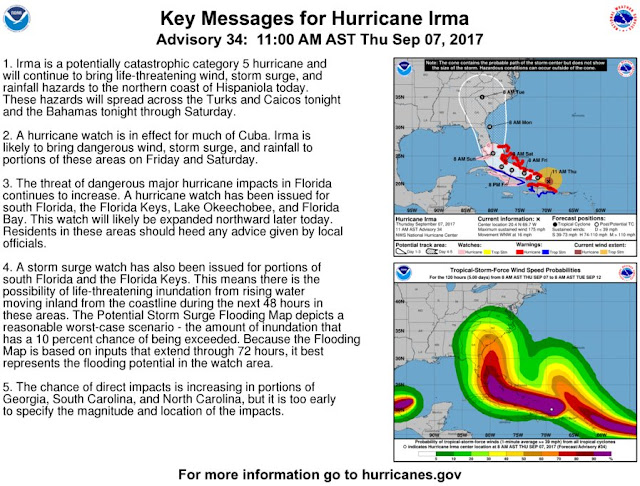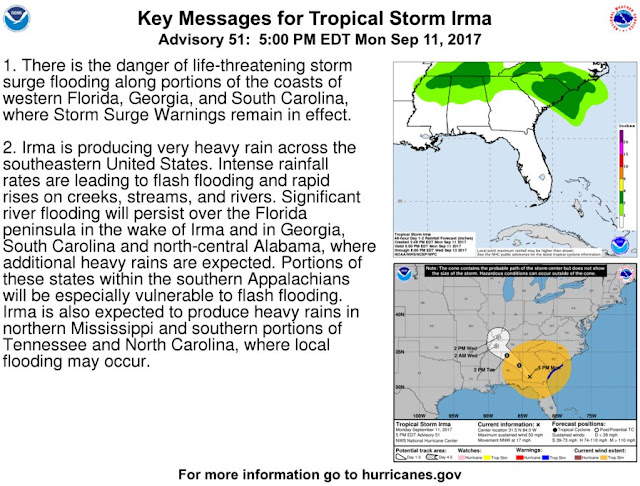It's been a tough September. We are thankful to
be in Trinidad (out of the hurricane belt), but it's truly heartbreaking to see all the islands, boats & homes destroyed and
lives lost. Haven't felt this strongly about hurricanes before.
Perhaps
it's because we are closer than ever before (geographically). Perhaps we know how much we
put into making the boat our home and seeing so many of them destroyed
is gut wrenching. And perhaps it's because a lot of the islands we've
been looking forward to visit are now wiped out or in complete chaos.
Countries affected by the hurricanes this season include Antigua and Barbuda, Anguilla, St. Barts, Cuba, St. Martin, St. Maarten, British Virgin Islands, Dominica, Guadaloupe, Dominican Republic, Haiti, Puerto Rico, Florida and many more..
Countries affected by the hurricanes this season include Antigua and Barbuda, Anguilla, St. Barts, Cuba, St. Martin, St. Maarten, British Virgin Islands, Dominica, Guadaloupe, Dominican Republic, Haiti, Puerto Rico, Florida and many more..
 |
| Courtesy of Worldatlas.com |
With all this happening, I couldn't help but realise how little I knew about hurricanes and wanted to learn more about them i.e. how they are formed, categorised, and even named. If you're interested (like me), read on.
Disclaimer: The following information is obtained from various sources i.e. NASA, National Hurricane Center, The Weather Network, Wikipedia.
Hurricanes do not just appear overnight; it starts off over warm ocean waters within 8º and 15º
north and south of the equator where surface sea temperatures reach
27ºC. The air above the warm sea is heated and rises. This causes low
pressure. As the air rises it cools then condenses, forming rain clouds.
It begins as a tropical disturbance which is a mass of thunderstorms with light wind circulation. Depending on the wind speed, it grows into a tropical depression, then into a tropical storm and becomes a hurricane when wind reaches 119 kmph or higher (more on this below).
It begins as a tropical disturbance which is a mass of thunderstorms with light wind circulation. Depending on the wind speed, it grows into a tropical depression, then into a tropical storm and becomes a hurricane when wind reaches 119 kmph or higher (more on this below).
So, what's a Hurricane?
Hurricanes are large, swirling storms. They produce winds of 119 kmph (74 mph) or higher. That's faster than a cheetah, the fastest animal on land. Winds from a hurricane can damage buildings and trees {obviously}.
A hurricane is a tropical storm that occurs in the Atlantic Ocean, Caribbean Sea and northeastern Pacific Ocean, a typhoon occurs in the northwestern Pacific Ocean, and a cyclone occurs in the south Pacific or Indian Ocean. These all form over warm ocean waters and they are the same weather phenomenon - just different names for different places.
 |
| Image source: http://blog.grandincentives.com |
How does it become a Hurricane?
As we already know:
Tropical Disturbance ➜ Tropical Depression ➜ Tropical Storm ➜ Hurricane
- A tropical disturbance is a mass of thunderstorms with slight wind circulation, sometimes grows into a tropical depression if its winds reach 37 kmph (23 mph).
- A tropical depression becomes a tropical storm if its winds reach 63 kmph (39 mph).
- A tropical storm becomes a hurricane if its winds reach 119 kmph (74 mph).
The Saffir-Simpson Hurricane Scale is used to rate hurricane intensity in the Atlantic Basin. There 5 categories of hurricane and they are based on wind speed.
- Category 1: Winds 119-153 kmph (74-95 mph) - faster than a cheetah
- Category 2: Winds 154-177 kmph (96-110 mph) - as fast or faster than a baseball pitcher's fastball
- Category 3: Winds 178-208 kmph (111-129 mph) - similar, or close, to the serving speed of many professional tennis players
- Category 4: Winds 209-251 kmph (130-156 mph) - faster than the world's fastest rollercoaster
- Category 5: Winds more than 252 kmph (157 mph) - similar, or close, to the speed of some high-speed trains
Below are some facts (from various sources) and key messages issued by hurricanes.gov during Hurricanes Harvey, Irma, Jose and Maria:
Hurricane Harvey
- Formed August 17th and dissipated on September 3rd.
- Developed from a tropical wave to the east of the Lesser Antilles, reaching tropical storm status on August 17th.
- On August 26th, Harvey rapidly intensified from a tropical storm to a hurricane and made landfall at peak intensity at Rockport, Texas, USA with winds of 215 kmph (130 mph).
- Moved over the Copano Bay (northwestern extension of Aransas Bay, west of Rockport, Texas) and made a second landfall as a Category 3 hurricane just north of Holiday Beach, Texas.
- Harvey stayed inland for a couple of days dropping very heavy rainfall causing widespread flash flooding.
- Produced 1.31 m (51.88 inches) of rain at Cedar Bayou, Texas – the most ever recorded in the mainland US and breaking the old record of 1.22 m (48 inches) set in Texas by Tropical Storm Claudette in 1979. Apparently it was still raining when the gauge broke, so the number may be higher than even Hawaii’s record of 1.32 m (52 inches).
- On August 30th, Harvey made its final landfall just west of Cameron, Louisiana with winds of 75 kmph (45 mph), and weakened to a tropical depression over central Louisiana later that day.
- The costliest hurricane on record at $198.63 billion in damage, also making it the costliest natural disaster ever in the United States.
Hurricane Irma
- Is the most powerful Atlantic Ocean hurricane recorded in history. Irma generated more Accumulated Cyclone Energy than any Atlantic tropical cyclone on record, and more than the first eight named storms of the season (including Harvey) combined.
- Formed August 30th and dissipated on September 16th.
- Developed on August 30th, 2017 near the Cape Verde Islands, Irma rapidly intensified shortly after formation, becoming a Category 2 hurricane within 24 hours and Category 3 shortly afterward.
- On September 6th, Irma reached a maximum wind speed of 298 km/h (185 mph) – tied with the Florida Keys Hurricane of 1935, Gilbert (1988), and Wilma (2005) for the second strongest max winds of all time in an Atlantic hurricane. The record is held by Hurricane Allen (1980), which reached 305 km/h (190 mph).
- Maintained 298 kmph (185 mph) for 37 hours, the previous record time anywhere on the globe for a storm of that intensity was Typhoon Haiyan, which was at peak intensity for 24 hours.
- Was a Category 5 for 3.25 days, tied with the Cuba Hurricane of 1932 as the longest time at Category 5 strength.
- Was the first Category 5 hurricane to make landfall in Cuba since 1924, and the first major hurricane (Category 3 or greater) to make landfall in Florida since Wilma (2005).
- The storm caused catastrophic damage in Barbuda, Saint Barthélemy, Saint Martin, Anguilla, and the Virgin Islands as a Category 5 hurricane.
Hurricane Jose
- A powerful and erratic tropical storm which was the longest-lived Atlantic hurricane since Hurricane Nadine in 2012.
- Formed September 5th and dissipated on September 26th.
- Is the 5th hurricane of the season. It's maximum sustained wind speed is 209 kmph (130 mph).
- Developed into a tropical storm on September 5th from a tropical wave that left the west coast of Africa.
- Rapidly intensified on September 6th and on September 8th, Jose reached its peak intensity as a high-end Category 4 hurricane.
- Fortunately, Jose did not make any landfall. Having said that, Jose still brought tropical storm force winds to Barbuda and Saint Martin as well as heavy rain, swells, and rough surf to the East Coast of the United States, causing beach erosion and some flooding.
Hurricane Maria
- The third major hurricane in a row to threaten the Leeward Islands with a direct strike or major impacts within two weeks, after Hurricane Irma caused catastrophic damage there.
- Formed September 16th and dissipated on October 3rd.
- Developed on September 16, east of the Lesser Antilles.
- Developed into a Category 5 strength on September 18th just before making landfall on Dominica, becoming the first Category 5 hurricane on record to strike the island, causing catastrophic damage.
- On September 20th, Maria hit Puerto Rico as a Category 4 with winds of 225 kmph (140 mph), making it the strongest storm to hit the island in 80 years.
- Maria also hit the Dominican Republic, Haiti, and Turks and Caicos, causing widespread flooding.
- Moving slowly to the north, Maria gradually degraded and weakened to a tropical storm on September 28th.
How Are Hurricanes Named?
As you know, there can be more than one hurricane at a time. Names make it easier to keep track of and talk about storms.
A storm is given a name only if it becomes a tropical storm i.e. winds reach 63 kmph (39 mph). That name stays with the storm if it goes on to become a hurricane. (Tropical disturbances and depressions don't have names).
Each year, tropical storms are named in alphabetical order. The names come from a list of names for that year. There are six lists of names. Lists are reused every six years.
If a storm does a lot of damage, its name is sometimes taken off the list. It is then replaced by a new name that starts with the same letter. This is carried out annually by an international committee of the World Meteorological Organization (WMO).
You can see the six list of names here:
Hope you found this somewhat interesting/informative. This post serves as a reminder that we need to look after our mother earth. Global warming/climate change is real. As our ocean waters get warmer, the hurricanes become more frequent and stronger.
Good to know:
What is Global Warming
35 Easy Ways to Stop Global Warming
Updated: "The 2017 Atlantic hurricane season was a hyperactive, deadly, and extremely destructive season, featuring 17 named storms, ranking alongside 1936 as the fifth-most active season since records began in 1851, and the most active since 2012.
The season also featured both the highest total accumulated cyclone energy (ACE) and the highest number of major hurricanes since 2005. All ten of the season's hurricanes occurred in a row, the greatest number of consecutive hurricanes in the satellite era.
In addition, it was by far the costliest season on record, with a preliminary total of over $368.66 billion (USD) in damages, which is nearly three times the cost of 2005’s total, and essentially all of which was due to three of the season's major hurricanes — Harvey, Irma, and Maria.
This season is also one of only six years on record to feature multiple Category 5 hurricanes, and only the second to feature two hurricanes making landfall at that intensity. This season is the only season on record in which three hurricanes each had an ACE of over 40: Irma, Jose, and Maria." - Wikipedia





















No comments:
Post a Comment
THANKS FOR STOPPING BY. WE'D LOVE TO HEAR FROM YOU!